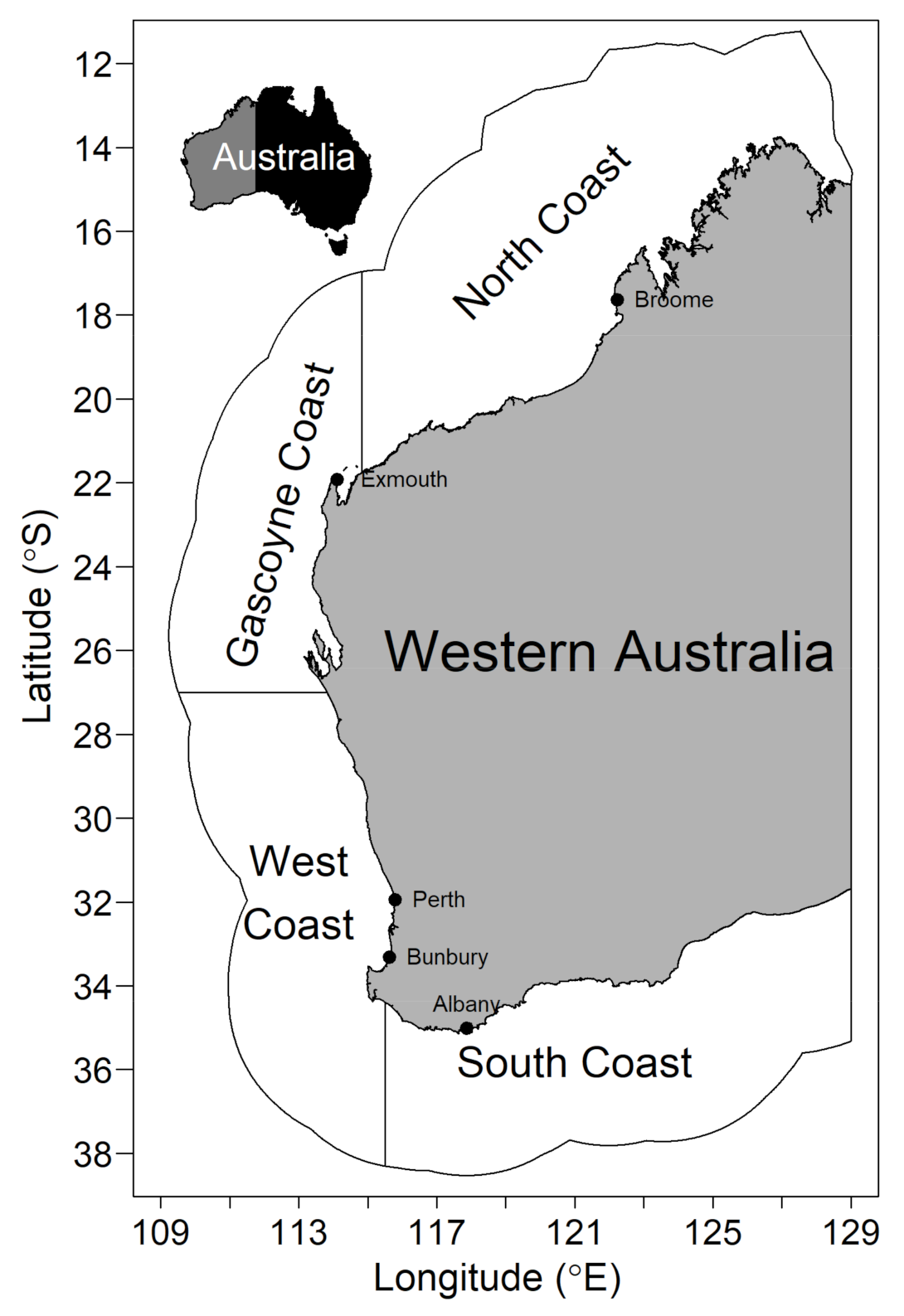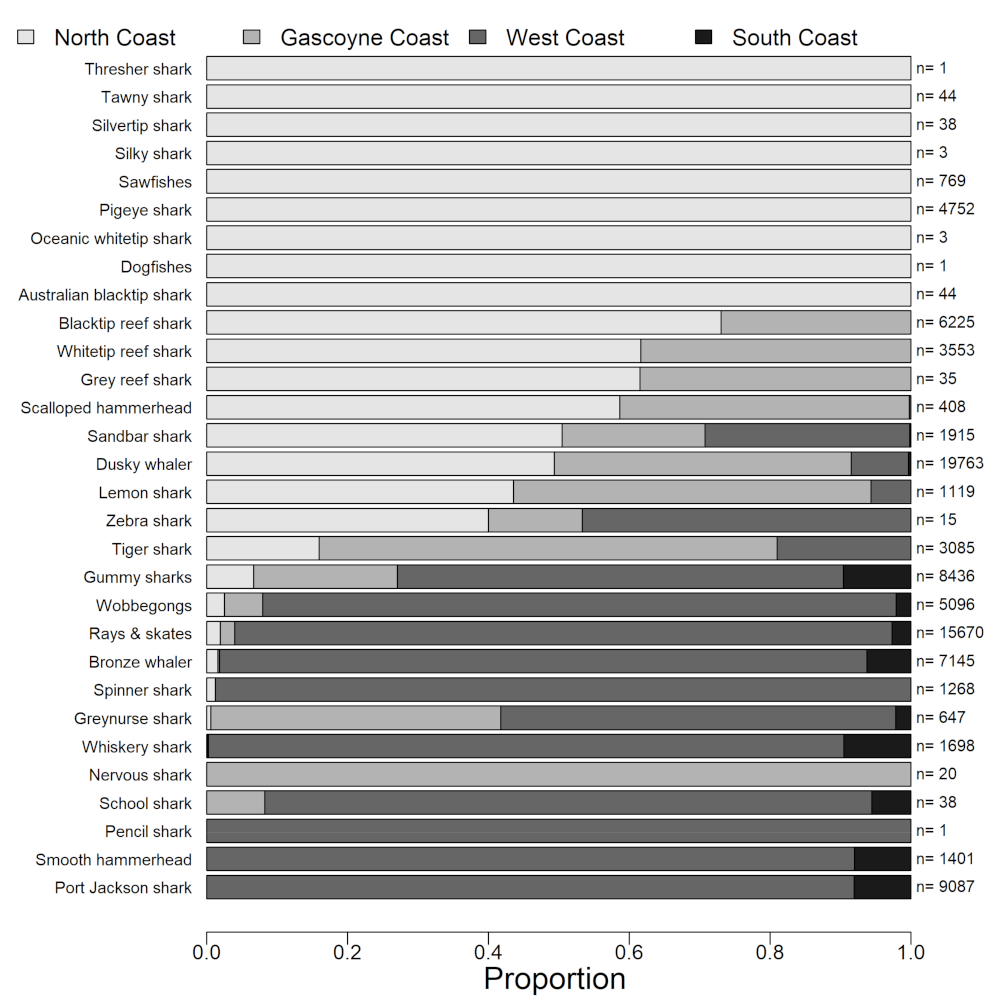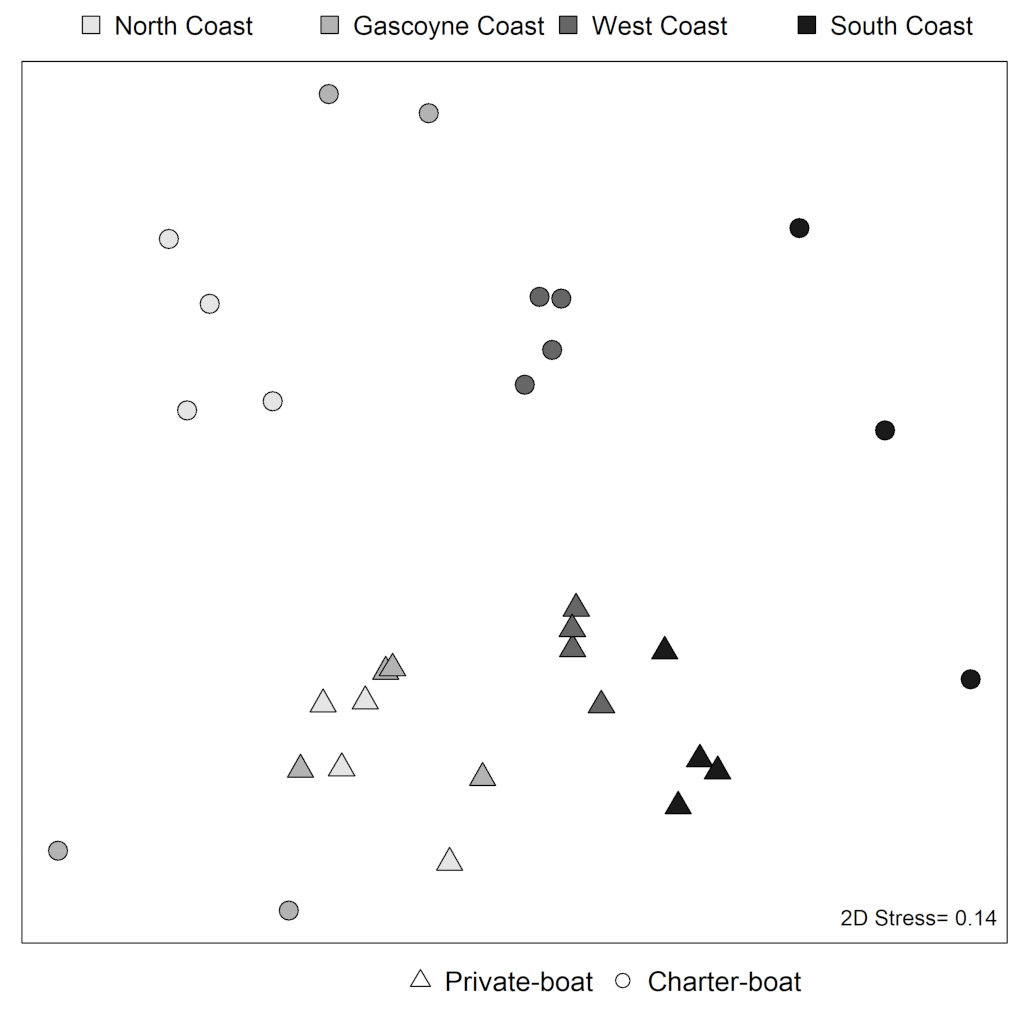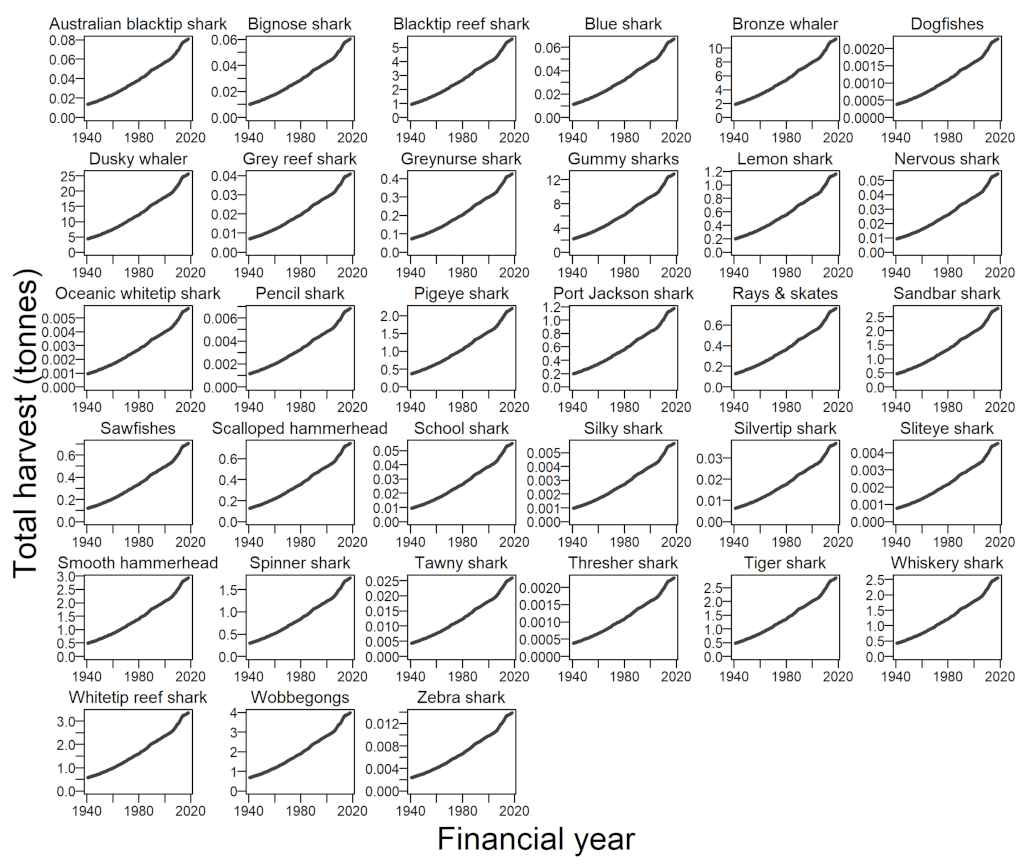Recreational Harvest of Sharks and Rays in Western Australia Is Only a Minor Component of the Total Harvest
Abstract
1. Introduction
2. Materials and Methods
2.1. Data Sources
2.2. Data Analyses
2.2.1. Reapportioning Generic Taxa
2.2.2. Patterns in Species Composition
2.2.3. Calculation of Shore-Based Recreational Fishing
2.2.4. Accounting for Post-Release Mortality
2.2.5. Conversion of Numbers to Weights
2.2.6. Reconstruction of Time Series
3. Results
4. Discussion
5. Conclusions
Supplementary Materials
Author Contributions
Funding
Institutional Review Board Statement
Informed Consent Statement
Data Availability Statement
Acknowledgments
Conflicts of Interest
References
- Arlinghaus, R.; Abbott, J.K.; Fenichel, E.P.; Carpenter, S.R.; Hunt, L.M.; Alós, J.; Klefoth, T.; Cooke, S.J.; Hilborn, R.; Jensen, O.P.; et al. Governing the recreational dimension of global fisheries. Proc. Natl. Acad. Sci. USA 2019, 116, 5209–5213. [Google Scholar] [CrossRef]
- Gallagher, A.J.; Hammerschlag, N.; Danylchuk, A.J.; Cooke, S.J. Shark recreational fisheries: Status, challenges, and research needs. Ambio 2017, 46, 385–398. [Google Scholar] [CrossRef] [PubMed]
- McPhee, D.P. Urban recreational fisheries in the australian coastal zone: The sustainability challenge. Sustainability 2017, 9, 422. [Google Scholar] [CrossRef]
- Cooke, S.; Cowx, I. The role of recreational fishing in global fish crises. Bioscience 2004, 54, 857–859. [Google Scholar] [CrossRef]
- McPhee, D.; Leadbitter, D.; Skilleter, G. Swallowing the bait: Is recreational fishing ecologically sustainable? Pac. Conserv. Biol. 2002, 8, 40–51. [Google Scholar] [CrossRef]
- Cooke, S.J.; Hogan, Z.S.; Butcher, P.A.; Stokesbury, M.J.W.; Raghavan, R.; Gallagher, A.J.; Hammerschlag, N.; Danylchuk, A.J. Angling for endangered fish: Conservation problem or conservation action? Fish Fish. 2016, 17, 249–265. [Google Scholar] [CrossRef]
- Kyne, P.; Feutry, P. Recreational fishing impacts on threatened river sharks: A potential conservation issue. Ecol. Manag. Restor. 2017, 18, 209–213. [Google Scholar] [CrossRef]
- Dulvy, N.K.; Fowler, S.L.; Musick, J.A.; Cavanagh, R.D.; Kyne, P.M.; Harrison, L.R.; Carlson, J.K.; Davidson, L.N.; Fordham, S.V.; Francis, M.P.; et al. Extinction risk and conservation of the world’s sharks and rays. eLife 2014, 3, e00590. [Google Scholar] [CrossRef] [PubMed]
- Walker, T.I. Can shark resources be harvested sustainably? A question revisited with a review of shark fisheries. Mar. Freshw. Res. 1998, 49, 553–572. [Google Scholar] [CrossRef]
- Field, I.; Meekan, M.; Buckworth, R.; Bradshaw, C. Susceptibility of sharks, rays and chimaeras to global extinction. Adv. Mar. Biol. 2009, 56, 275–363. [Google Scholar] [CrossRef]
- Walker, T.I. Stock assessments of the gummy shark, Mustelus antarcticus Gunther, in Bass Strait and off South Australia. In Population Dynamics for Fisheries Management; Hancock, D.A., Ed.; Australian Government Printing Service: Canberra, Australia, 1994; pp. 173–187. [Google Scholar]
- Punt, A.E.; Walker, T.I. Stock assessment and risk analysis for the school shark (Galeorhinus galeus) off southern Australia. Mar. Freshw. Res. 1998, 49, 719–731. [Google Scholar] [CrossRef]
- Cortés, E.; Brooks, L.; Scott, G. Stock Assessment of large coastal sharks in the U.S. Atlantic and Gulf of Mexico. In Sustainable Fisheries Division Contribution SFD-2/03-177; National Oceanic and Atmospheric Administration, National Marine Fisheries Service, Southeast Fisheries Science Center: Panama City, FL, USA, 2002; pp. 1–63. [Google Scholar]
- Zeller, D.; Darcy, M.; Booth, S.; Lowe, M.K.; Martell, S. What about recreational catch?. Potential impact on stock assessment for Hawaii’s bottomfish fisheries. Fish. Res. 2008, 91, 88–97. [Google Scholar] [CrossRef]
- Ryan, K.; Hall, N.; Lai, E.; Smallwood, C.; Tate, A.; Taylor, S.; Wise, B. Statewide Survey of Boatbased Recreational Fishing in Western Australia 2017/18; Fisheries Research Report No. 297; Department of Primary Industries and Regional Development: Perth, WA, Australia, 2019. [Google Scholar]
- Simpfendorfer, C.; Donohue, K.J. Keeping the fish in “fish and chips”: Research and management of the Western Australian shark fishery. Mar. Freshw. Res. 1998, 49, 593–600. [Google Scholar] [CrossRef]
- Whitley, G.P. Preliminary Report on the Long Line Fishery at Bunbury, W.A.; Unpublished Report; Western Australian Marine Research Laboratories: North Beach, Australia, 1943; 9p. [Google Scholar]
- Braccini, M.; Blay, N.; Hesp, A.; Molony, B. Resource Assessment Report Temperate Demersal Elasmobranch Resource of Western Australia; Fisheries Research Report 294; Department of Primary Industries and Regional Development: Perth, WA, Australia, 2018. [Google Scholar]
- DoF. Recreational Fishing in Western Australia—Fish Identification Guide, 5th ed.; Fisheries Occasional Publication No. 103; Department of Fisheries: Perth, WA, Australia, 2017. [Google Scholar]
- DoF. Recreational Fishing in Western Australia—Fishing Location Guide; Fisheries Occasional Publication No. 92; Department of Fisheries: Perth, WA, Australia, 2011. [Google Scholar]
- Ryan, K.L.; Wise, B.S.; Hall, N.; Pollock, K.; Sulin, E.; Gaughan, D. An Integrated System to Survey Boat-Based Recreational Fishing in Western Australia 2011/12; Fisheries Research Report No.249; Department of Fisheries: Perth, WA, Australia, 2013. [Google Scholar]
- Ryan, K.; Hall, N.; Lai, E.; Smallwood, C.; Taylor, S.; Wise, B. State-Wide Survey of Boat-Based Recreational Fishing in Western Australia 2013-14; Fisheries Research Report No. 268; Department of Fisheries: Perth, WA, Australia, 2015. [Google Scholar]
- Ryan, K.; Hall, N.; Lai, E.; Smallwood, C.; Taylor, S.; Wise, B. Statewide Survey of Boat-Based Recreational Fishing in Western Australia 2015/16; Fisheries Research Report No. 287; Department of Primary Industries and Regional Development: Perth, WA, Australia, 2017. [Google Scholar]
- Telfer, C. The Western Australian Charter Boat Industry: Working towards Long-Term Sustainability. Master’s Thesis, School of Natural Sciences, Edith Cowan University, Perth, WA, Australia, 2010. [Google Scholar]
- R Core Team. R: A Language and Environment for Statistical Computing; R Foundation for Statistical Computing: Vienna, Austria, 2018; Available online: https://www.R-project.org/ (accessed on 1 March 2018).
- Braccini, M.; Taylor, S. The spatial segregation patterns of sharks from Western Australia. R. Soc. Open Sci. 2016, 3, 160306. [Google Scholar] [CrossRef]
- Braccini, M.; Molony, B.; Blay, N. Patterns in abundance and size of sharks in northwestern Australia: Cause for optimism. ICES J. Mar. Sci. 2020, 77, 72–82. [Google Scholar] [CrossRef]
- Oksanen, J.; Blanchet, F.G.; Friendly, M.; Kindt, R.; Legendre, P.; McGlinn, D.; Minchin, P.R.; O’Hara, R.B.; Simpson, G.L.; Solymos, P.; et al. Vegan: Community Ecology Package; R Package Version 2.5-6. 2019. Available online: https://CRAN.R-project.org/package=vegan (accessed on 1 March 2018).
- Gulak, S.; de Ron Santiago, A.; Carlson, J. Hooking mortality of scalloped hammerhead Sphyrna lewini and great hammerhead Sphyrna mokarran sharks caught on bottom longlines. African J. Mar. Sci. 2015, 37, 267–273. [Google Scholar] [CrossRef]
- Frick, L.; Reina, R.; Walker, T. Stress related physiological changes and post-release survival of Port Jackson sharks (Heterodontus portusjacksoni) and gummy sharks (Mustelus antarcticus) following gill-net and longline capture in captivity. J. Exp. Mar. Bio. Ecol. 2010, 385, 29–37. [Google Scholar] [CrossRef]
- Gallagher, A.; Serafy, J.; Cooke, S.; Hammerschlag, N. Physiological stress response, reflex impairment, and survival of five sympatric shark species following experimental capture and release. Mar. Ecol. Prog. Ser. 2014, 496, 207–218. [Google Scholar] [CrossRef]
- Ellis, J.R.; McCully Phillips, S.R.; Poisson, F. A review of capture and post-release mortality of elasmobranchs. J. Fish Biol. 2016, 90, 653–722. [Google Scholar] [CrossRef] [PubMed]
- Rogers, P.J.; Knuckey, I.; Hudson, R.J.; Lowther, A.D.; Guida, L. Post-release survival, movement, and habitat use of school shark Galeorhinus galeus in the Great Australian Bight, southern Australia. Fish. Res. 2017, 187, 188–198. [Google Scholar] [CrossRef]
- Smallwood, C.B.; Tate, A.; Ryan, K.L. Weight-Length Summaries for Western Australian Fish Species Derived from Surveys of Recreational Fishers at Boat Ramps; Fisheries Research Report No. 278; Department of Primary Industries and Regional Development: Perth, WA, Australia, 2018. [Google Scholar]
- DPIRD. Annual Report 2019; Department of Primary Industries and Regional Development: Perth, WA, Australia, 2019. [Google Scholar]
- Molony, B.; McAuley, R.B.; Rowland, F. Northern shark fisheries status report: Statistics only. In Status Reports of the Fisheries and Aquatic Resources of Western Australia 2012/13: The State of the Fsheries; Fletcher, W.J., Santoro, K., Eds.; Department of Fisheries: Perth, WA, Australia, 2013; pp. 216–217. [Google Scholar]
- Braccini, M.; Blay, N. Temperate demersal gillnet and demersal longline fisheries recource status report 2018. In Status Reports of the Fisheries and Aquatic Resources of Western Australia 2016/17: The State of the Fisheries; Gaughan, D.J., Santoro, K., Eds.; Department of Primary Industries and Regional Development: Perth, WA, Australia, 2018; pp. 170–174. [Google Scholar]
- Henry, G.; Lyle, J. The National Recreational and Indigenous Fishing Survey; RDC Project No.99/158; New South Wales Fisheries: Cronulla, Australia, 2003. [Google Scholar]
- Cheshire, K.; Ward, P.; Sahlqvist, P.; Summerson, R. Monitoring the Recreational Take of Shark Species of Relevance to Commonwealth Fisheries; Prepared for the Recreational Fishing Industry Development Strategy; Department of Agriculture: Canberra, Australia, 2013. [Google Scholar]
- Taylor, S.M.; Braccini, J.; McAuley, R.; Fletcher, W.J. Review of Potential Fisheries and Marine Management Impacts on the South-Western Australian White Shark Population; Fisheries Research Report 277; Department of Fisheries: Perth, WA, Australia, 2016. [Google Scholar]
- Pepperell, J. NSW DPI Game Fish Tagging Program Report 2010–2011; Pepperell Research: New South Wales, Australia, 2011. [Google Scholar]
- Last, P.R.; Stevens, J.D. Sharks and Rays of Australia, 2nd ed.; CSIRO Publishing: Collingwood, VIC, Australia, 2009. [Google Scholar]
- Mitchell, J.D.; McLean, D.L.; Collin, S.P.; Taylor, S.; Jackson, G.; Fisher, R.; Langlois, T.J. Quantifying shark depredation in a recreational fishery in the Ningaloo Marine Park and Exmouth Gulf, Western Australia. Mar. Ecol. Prog. Ser. 2018, 587, 141–157. [Google Scholar] [CrossRef]
- Mcclellan Press, K.; Mandelman, J.; Burgess, E.; Cooke, S.J.; Nguyen, V.M.; Danylchuk, A.J. Catching sharks: Recreational saltwater angler behaviours and attitudes regarding shark encounters and conservation. Aquat. Conserv. Mar. Freshw. Ecosyst. 2016, 26, 689–702. [Google Scholar] [CrossRef]
- De Faria, F. Recreational Fishing of Sharks in the Great Barrier Reef World Heritage Area: Species Composition and Incidental Capture Stress. Master’s Thesis, School of Earth and Environmental Sciencies, James Cook University, Townsville, QLD, Australia, 2012. [Google Scholar]
- Pepperell, J.G. Trends in the distribution, species composition and size of sharks caught by Gamefish Anglers off South-eastern Australia, 1961–1990. Aust. J. Mar. Freshw. Res. 1992, 43, 213–225. [Google Scholar] [CrossRef]
- Jones, K. South Australian Recreational Fishing Survey 2007/08; South Australian Fisheries Management Series Paper No 54; PIRSA Fisheries: Adelaide, Australia, 2009. [Google Scholar]
- Young, M.; Foale, S.; Bellwood, D. Impacts of recreational fishing in Australia: Historical declines, self-regulation and evidence of an early warning system. Environ. Conserv. 2014, 41, 350–356. [Google Scholar] [CrossRef]




| Common Name | Scientific Name | Numbers | Average Weight (kg) | Post-Release Mortality | |
|---|---|---|---|---|---|
| Retained | Released | ||||
| Carcharhiniformes | |||||
| Silvertip Shark | Carcharhinus albimarginatus | 0 | 46 | 5.4 | 0.3 |
| Bignose Shark | Carcharhinus altimus | 0 | 33 | 5.4 | 0.3 |
| Grey Reef Shark | Carcharhinus amblyrhynchos | 15 | 199 | 5.4 | 0.3 |
| Pigeye Shark | Carcharhinus amboinensis | 7 | 7319 | 5.4 | 0.3 |
| Bronze Whaler | Carcharhinus brachyurus | 5639 | 11,956 | 5.4 | 0.3 |
| Spinner Shark | Carcharhinus brevipinna | 1048 | 2285 | 5.4 | 0.3 |
| Nervous Shark | Carcharhinus cautus | 7 | 24 | 4.2 | 0.3 |
| Silky Shark | Carcharhinus falciformis | 7 | 11 | 5.4 | 0.3 |
| Oceanic Whitetip Shark | Carcharhinus longimanus | 17 | 830 | 5.4 | 0.3 |
| Blacktip Reef Shark | Carcharhinus melanopterus | 827 | 17,178 | 5.4 | 0.3 |
| Dusky Whaler | Carcharhinus obscurus | 3129 | 36,523 | 5.4 | 0.3 |
| Sandbar Shark | Carcharhinus plumbeus | 989 | 3249 | 5.4 | 0.3 |
| Australian Blacktip Shark | Carcharhinus tilstoni | 80 | 117 | 5.4 | 0.3 |
| Tiger Shark | Galeocerdo cuvier | 199 | 5920 | 5.4 | 0.3 |
| Sliteye Shark | Loxodon macrorhinus | 0 | 3 | 4.2 | 0.3 |
| Lemon Shark | Negaprion acutidens | 64 | 2489 | 5.4 | 0.3 |
| Blue Shark | Prionace glauca | 0 | 35 | 5.4 | 0.3 |
| Whitetip Reef Shark | Triaenodon obesus | 290 | 6650 | 4.2 | 0.3 |
| Smooth Hammerhead | Sphyrna zygaena | 727 | 2121 | 5.4 | 0.6 |
| Scalloped Hammerhead | Sphyrna lewini | 59 | 906 | 5.4 | 0.6 |
| Gummy Sharks | Mustelus antarcticus and M. stevensi | 10,433 | 7240 | 4.2 | 0.1 |
| Whiskery Shark | Furgaleus macki | 2454 | 1256 | 3.7 | 0.3 |
| School Shark | Galeorhinus galeus | 389 | 287 | 4.2 | 0.1 |
| Pencil Shark | Hypogaleus hyugaensis | 18 | 2 | 4.2 | 0.3 |
| Lamniformes | |||||
| Thresher Shark | Alopias vulpinus | 0 | 2 | 5.4 | 0.3 |
| Greynurse Shark | Carcharias taurus | 29 | 1270 | 5.4 | 0.13 |
| Heterodontiformes | |||||
| Port Jackson Shark | Heterodontus portusjacksoni | 138 | 17,715 | 4.2 | 0.05 |
| Orectolobiformes | |||||
| Wobbegongs | Orectolobidae | 1625 | 8369 | 6.7 | 0.05 |
| Tawny Shark | Nebrius ferrugineus | 2 | 199 | 5.4 | 0.3 |
| Zebra Shark | Stegostoma fasciatum | 10 | 32 | 5.4 | 0.3 |
| Squaliformes | |||||
| Dogfishes | Squalidae | 0 | 1 | 4.2 | 0.3 |
| Rhinopristiformes | |||||
| Sawfishes | Pristidae | 18 | 1489 | 5.4 | 0.3 |
| Rajiformes | |||||
| Rays and Skates | Rajidae | 478 | 30,249 | 0.5 | 0.16 |
Publisher’s Note: MDPI stays neutral with regard to jurisdictional claims in published maps and institutional affiliations. |
© 2021 by the authors. Licensee MDPI, Basel, Switzerland. This article is an open access article distributed under the terms and conditions of the Creative Commons Attribution (CC BY) license (https://creativecommons.org/licenses/by/4.0/).
Share and Cite
Braccini, M.; Lai, E.; Ryan, K.; Taylor, S. Recreational Harvest of Sharks and Rays in Western Australia Is Only a Minor Component of the Total Harvest. Sustainability 2021, 13, 6215. https://doi.org/10.3390/su13116215
Braccini M, Lai E, Ryan K, Taylor S. Recreational Harvest of Sharks and Rays in Western Australia Is Only a Minor Component of the Total Harvest. Sustainability. 2021; 13(11):6215. https://doi.org/10.3390/su13116215
Chicago/Turabian StyleBraccini, Matias, Eva Lai, Karina Ryan, and Stephen Taylor. 2021. "Recreational Harvest of Sharks and Rays in Western Australia Is Only a Minor Component of the Total Harvest" Sustainability 13, no. 11: 6215. https://doi.org/10.3390/su13116215
APA StyleBraccini, M., Lai, E., Ryan, K., & Taylor, S. (2021). Recreational Harvest of Sharks and Rays in Western Australia Is Only a Minor Component of the Total Harvest. Sustainability, 13(11), 6215. https://doi.org/10.3390/su13116215






